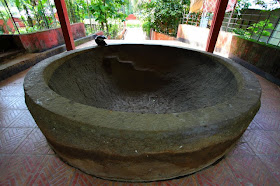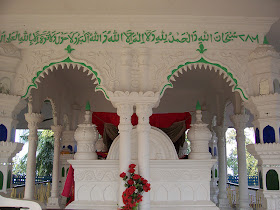Hajo is situated on the north bank of the Brahamputra 32 km from Guwahati. Hajo is an extremely important destination for Hindus, Muslims and Buddhists. This is an ancient pilgrimage centre for three religions Hinduism, Islam and Buddhism. A number of religious places like temples and mosques dot the land of Hajo. Hajo is a remarkable example of communal harmony.
Primary amongst them is the Hayagriva Mahadeva temple accessible via a long stone stairway. At the foot of the stairway is a large pond inhabited by one of Hajo's oldest residents - a giant turtle. This temple is important for both the Hindu and the Buddhist community. Within the temple is an image of Vishnu which quiet closely resembles the one at Jagannath Temple in Puri in Orissa. This temple is also regarded as a Buddhist shrine by Buddhist Lamas and Butiyas, who profess Buddhism. It is believed that, Lord Buddha attained Nirvana at this place.
The temple was destroyed by Kalapahar ( who is said to have destroyed hundreds of temple in India) and was rebuilt in 1543 by the Koch king Raghudev. A smaller temple was built nearby by Ahom king Pramatta Singh where Doul is celebrated on a grand scale every year.
Hajo Assam is also considered to be a Muslim pilgrimage centre. An Iraqi Prince, Pir Giasuddin Aulia established a mosque in Hajo in the 12th century, while visiting the place to spread the word of the Prophet. The mosque is often referred to as Poa Mecca – being 4th in the line of sanctity to the shrine at Mecca. The inscription of the wall of the Mosque tells us that it was constructed by Mir Lutufullah-i-Shiraji in 1657, during the reign of the Mughal emperor Shahjahan. A tomb in the front area of the mosque belongs to Gyasuddin Aulia who initially tried to spread Islam in the area. The mosque, it is also believed, is built on the foundation that in some quantity consists of earth brought from Mecca.
“Bhimar Charia”, just about one and a half kilometres from the Hayagriva Madav Temple. According to Hindu mythology, the Pandavas had taken shelter in this region during their agyatvas or during the period in hiding. One can see the stone bowl used by Bhima (one of the Pandava brothers) during this agyatvas. Some say that this bowl was used by Bhima to eat. But a picture from another angle shows some steps on the inner side of the bowl. Maybe he might have used it to have a bath( Helmet to scale).
Hajo’s bell metal work is renowned. In Hajo of Kamrup district, Brass is an important cottage industry. Sarthebari in the same district is famous for bell metal crafts. The artisans of Assam make Kalah (water pot), Sarai, Kahi (dish), Bati (bowl), Lota and Tal (cymbals) out of these materials. The use of these metals were seen even in ancient times in utensils and statues. Today, they are also used for making fancy household items.
It is interesting to know that, since time immemorial, all the brass and bell metal utensils used in the Hayagriva Temple is made by the Moria Community—a muslim community. No wonder Hajo is said to be the meeting place of the 3 religions—Hinduism, Buddhism, Islam.
Getting There By Air - The airport at Guwahati is the closest one from Hajo. Flights from here connect to destinations like New Delhi, Kolkata, Mumbai, Chennai, Jorhat, Dibrugarh, Tezpur, North Lakhimpur and Silchar. There is also a direct flight from Guwahati for Bangkok on every Monday and Thursday.
By Rail - Guwahati also happens to be nearest railhead to reach Hajo. Trains from here link to New Delhi and Kolkata directly and provide connectivity to destinations like Mumbai, Chennai, Bangalore, Kochi and Thiruvananthapuram etc.
By Road - Buses also connect Guwahati to various destinations like Shillong, Silchar, Dibrugarh, Jorhat, Tezpur.
 |
| Hayagriva Mahadeva Temple Stone Staircase |
The temple was destroyed by Kalapahar ( who is said to have destroyed hundreds of temple in India) and was rebuilt in 1543 by the Koch king Raghudev. A smaller temple was built nearby by Ahom king Pramatta Singh where Doul is celebrated on a grand scale every year.
 |
| Hayagriva Mahadeva temple |
 |
| Pond of Hayagriva Mahadeva temple |
 |
| Image of God Vishnu |
 |
| Pond of the Temple |
 |
| Poa Mecca Mosque |
“Bhimar Charia”, just about one and a half kilometres from the Hayagriva Madav Temple. According to Hindu mythology, the Pandavas had taken shelter in this region during their agyatvas or during the period in hiding. One can see the stone bowl used by Bhima (one of the Pandava brothers) during this agyatvas. Some say that this bowl was used by Bhima to eat. But a picture from another angle shows some steps on the inner side of the bowl. Maybe he might have used it to have a bath( Helmet to scale).
 |
| Stone bowl used by Bhima |
 |
| Brass Work in Hajo |
 |
| Hajo is famous for Belt work |
Getting There By Air - The airport at Guwahati is the closest one from Hajo. Flights from here connect to destinations like New Delhi, Kolkata, Mumbai, Chennai, Jorhat, Dibrugarh, Tezpur, North Lakhimpur and Silchar. There is also a direct flight from Guwahati for Bangkok on every Monday and Thursday.
By Rail - Guwahati also happens to be nearest railhead to reach Hajo. Trains from here link to New Delhi and Kolkata directly and provide connectivity to destinations like Mumbai, Chennai, Bangalore, Kochi and Thiruvananthapuram etc.
By Road - Buses also connect Guwahati to various destinations like Shillong, Silchar, Dibrugarh, Jorhat, Tezpur.


The bowl looks very interesting. Gosh! It's humungous.
ReplyDeleteThanks!!
ReplyDeleteI have been to this place once when i was in Guwahati. Nice write :))
ReplyDeleteThanks Shamsud!!!
ReplyDeleteWow, Fantastic temples, in corners of India,. Thanks for bringing this unique place to readers.
ReplyDeleteThanks Vetrimal for your sweet words!!
ReplyDeleteMe and My husband Ashwini loves Kuldhara village alot and we will go there in this October,and we are damn exited...:)
ReplyDelete